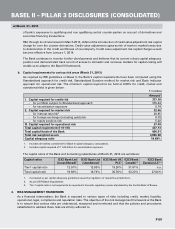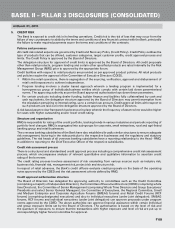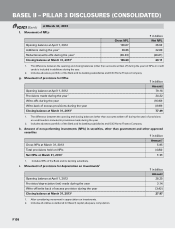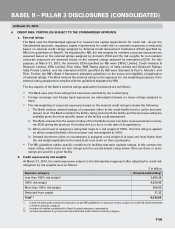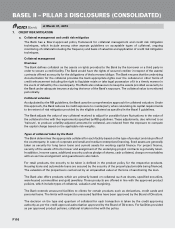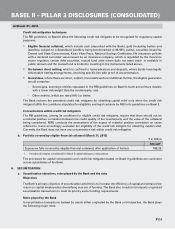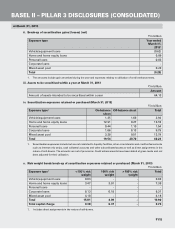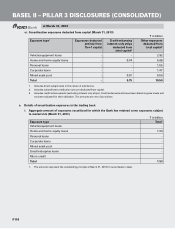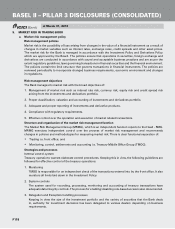ICICI Bank 2013 Annual Report Download - page 188
Download and view the complete annual report
Please find page 188 of the 2013 ICICI Bank annual report below. You can navigate through the pages in the report by either clicking on the pages listed below, or by using the keyword search tool below to find specific information within the annual report.
F110
7. CREDIT RISK MITIGATION
a. Collateral management and credit risk mitigation
The Bank has a Board approved policy framework for collateral management and credit risk mitigation
techniques, which include among other aspects guidelines on acceptable types of collateral, ongoing
monitoring of collateral including the frequency and basis of valuation and application of credit risk mitigation
techniques.
Collateral management
Overview
The Bank defines collateral as the assets or rights provided to the Bank by the borrower or a third party in
order to secure a credit facility. The Bank would have the rights of secured creditor in respect of the assets/
contracts offered as security for the obligations of the borrower/obligor. The Bank ensures that the underlying
documentation for the collateral provides the bank appropriate rights over the collateral or other forms of
credit enhancement including the right to liquidate retain or take legal possession of it in a timely manner in
the event of default by the counterparty. The Bank also endeavours to keep the assets provided as security to
the Bank under adequate insurance during the tenor of the Bank’s exposure. The collateral value is monitored
periodically.
Collateral valuation
As stipulated by the RBI guidelines, the Bank uses the comprehensive approach for collateral valuation. Under
this approach, the Bank reduces its credit exposure to counterparty when calculating its capital requirements
to the extent of risk mitigation provided by the eligible collateral as specified in the Basel II guidelines.
The Bank adjusts the value of any collateral received to adjust for possible future fluctuations in the value of
the collateral in line with the requirements specified by RBI guidelines. These adjustments, also referred to as
‘haircuts’, to produce volatility-adjusted amounts for collateral, are reduced from the exposure to compute
the capital charge based on the applicable risk weights.
Types of collateral taken by the Bank
The Bank determines the appropriate collateral for each facility based on the type of product and risk profile of
the counterparty. In case of corporate and small and medium enterprises financing, fixed assets are generally
taken as security for long tenor loans and current assets for working capital finance. For project finance,
security of the assets of the borrower and assignment of the underlying project contracts is generally taken.
In addition, in some cases, additional security such as pledge of shares, cash collateral, charge on receivables
with an escrow arrangement and guarantees is also taken.
For retail products, the security to be taken is defined in the product policy for the respective products.
Housing loans and automobile loans are secured by the security of the property/automobile being financed.
The valuation of the properties is carried out by an empanelled valuer at the time of sanctioning the loan.
The Bank also offers products which are primarily based on collateral such as shares, specified securities,
warehoused commodities and gold jewellery. These products are offered in line with the approved product
policies, which include types of collateral, valuation and margining.
The Bank extends unsecured facilities to clients for certain products such as derivatives, credit cards and
personal loans. The limits with respect to unsecured facilities have been approved by the Board of Directors.
The decision on the type and quantum of collateral for each transaction is taken by the credit approving
authority as per the credit approval authorisation approved by the Board of Directors. For facilities provided
as per approved product policies, collateral is taken in line with the policy.
BASEL II – PILLAR 3 DISCLOSURES (CONSOLIDATED)
at March 31, 2013



